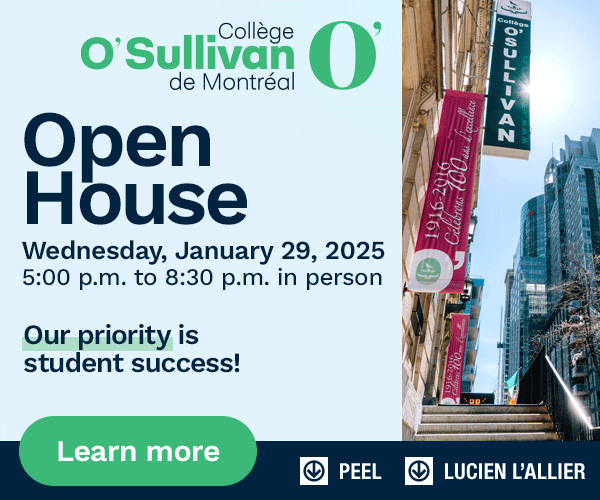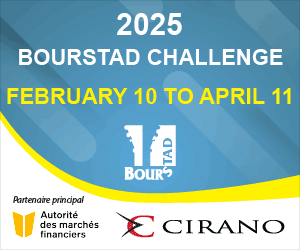By: Nancie Darlington Smith, Saugeen District Senior School
Saugeen District Senior School's (SDSS') Reconciliation Team unveiled a space dedicated to answering the Truth and Reconciliation Commission of Canada's Call to Action 63iii: "Building student capacity for intercultural understanding, empathy, and mutual respect."
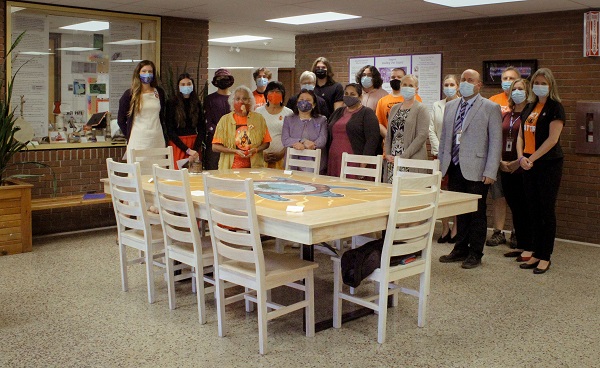
Hosting guests and contributors, including representatives from Saugeen First Nation, SDSS, and Bluewater District School Board, attended a live and virtual assembly on October 20, 2021. Thanks to the technical expertise of SDSS teacher Dan Weigand, the event was compiled into a video to be broadcast into classrooms and shared with guests from afar. The transformation of SDSS' front hall into Reconciliation Hall' was unveiled, complete with a museum-style display and information, along with a table surrounding a collaborative art piece from Treaties Recognition Week 2019. This day was a year in the making - a year that exposed a hidden history to many Canadians.
The traditional practice of smudging and offering a blessing was given by Elder Shirley John, who brought warmth and love to the ceremony. Beginning in the east, where the Anishnaabe people come from, Elder John cleansed the space with a prayer offered to the Four Directions. As Elder John prayed to the south, she asked that "we will have love in our hearts, and our minds and spirits as we walk on Mother Earth each and every day. We ask for blessings upon everything as we do the work we need to do."
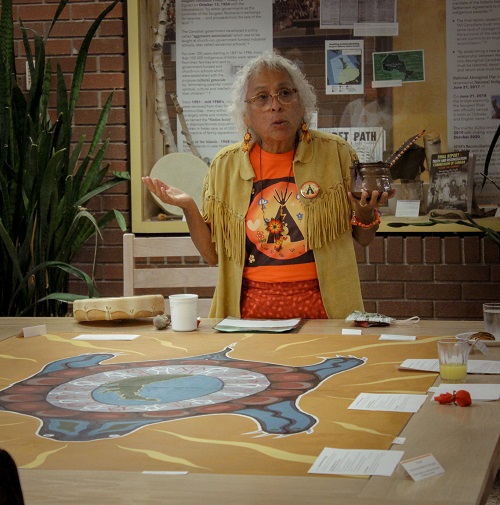
Sharing song to connect with ancestors and those who have gone on to the spirit world, Elder John also included survivors. She noted that, "in Saugeen, there are only six of us left that survived residential school." This touched those in attendance, recognizing the need to address the history, to acknowledge the suffering, and to make amends. Pointing to the display, Elder John gave thanks by saying, "I am so happy in my mind, and my heart, and my spirit that we have this. We have a lot of history here. It is much appreciated."
Greetings from Saugeen First Nation were brought by Councillor Melissa Snowdon, who is thankful that her children are growing up "in a time where mutual respect, understanding, and compassion are a priority." She challenges us to think thoughtfully and act for the long-term, rather than being attentive to a short-lived trend. "Let what is happening in our country today, in our communities today, be a stepping stone that strives each and every one of you to make reconciliation a life-long commitment."
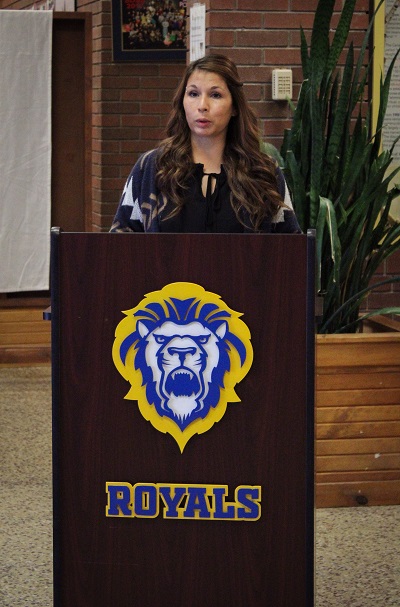
A mentor and advocate for the Indigenous community, Elder Ningwakwe George, Sitting Elder at SDSS since 2015 and a founding advisor to the Reconciliation Team, works in many capacities to "ensure that the young ones do not have to experience some of the things that we did." Held in high regard for her wisdom, knowledge of traditional information and customs, and reflection, Elder George noted that through the year-long process to create the space and assembly, the team members all learned a great deal.
Ensuring accuracy in the materials and information shared was of great importance. This included details of events that "disrupted our belief in ourselves as Anishnaabe." These disruptions have been experienced by Elder George, which included residential school and Indian Day School - sometimes referred to as Training School (and essentially a replication of residential school). "The only difference being was that we went home at night." (the Sixties Scoop and Missing and Murdered Indigenous Women and Girls (MMIWG))
Elder George's wisdom and reflection are evident in her observation that they were able to get through all of those things: "We are proud of who we are as Anishinaabe people [and] not only that we are giving back to our community." The following phrase kept coming back to her through the work on Reconciliation Hall, as information and artwork were prepared: "We are still here. After all that was done, we are still here."
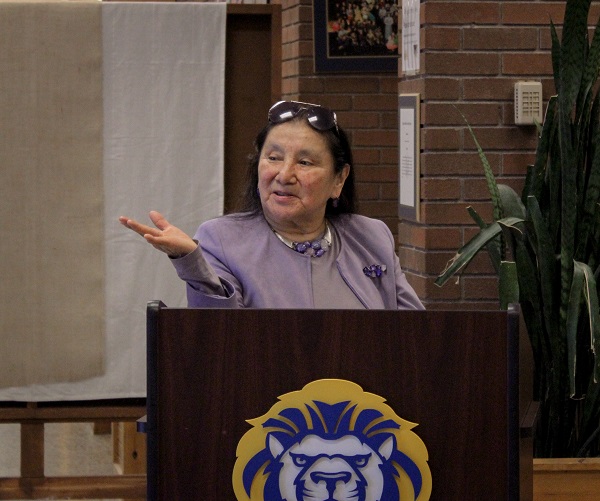
With the more than 7,500-year history of the Saugeen Ojibway Nation (SON) in the region, the virtual presentation of pre-recorded elements began with a Land Acknowledgment crafted carefully and mindfully to recognize that, as a community, we are guests on the land. The presentation that followed recognized the need to participate in the process of learning the truth in order to heal.
The lasting impact of the efforts to assimilate First Nations peoples, including the ongoing trauma from residential schools and the crisis of MMIWG, were discussed first - laying bare the truth that must be acknowledged before reconciliation can occur.
Teacher Bud Halpin, who along with Nancie Darlington Smith had determined that SDSS was ready to meet the expectations of becoming a Downie Wenjack Fund (DWF) Legacy School, provided a heartfelt message to students and guests as to why, as Canadians, we must apologize for the harm done and address ongoing systemic abuses. Relating to the excitement about the return to school, especially after a long absence, he connected with students:
"For most of us, September is a wonderful time of year. We return to school, we see our friends, we take part in extra-curricular sports, and then every night, we go home to our family. Often times, our family will come to the school to watch us play sports, to watch plays."
"Think of how different things were for children in residential schools. The children were taken from their homes. They did not go home at night. Often their parents did not know where they were. When they came back, they were changed, they had lost their language, and they had lost their culture. This is truly something [for which] Canada, as a nation, needs to apologize."
As a DWF Legacy School, SDSS is committed to the responsibility to "engage, empower, and connect students to further reconciliation." Held during Secret Path Week (October 17 - 22), which mark the days when Gord Downie and Chanie Wenjack entered the spirit world, respectively, the assembly featured videos from Mike Downie, co-founder of the DWF, and Harriet Visitor, Chanie's niece and DWF board member. There were also contributions from DWF Artist Ambassadors, Dr. Duke Redbird, Emily Kewageshig, and Reuben Bullock.
Long before SDSS formally accepted responsibility as a DWF Legacy School, regular activities to celebrate and honour First Nations community actions were becoming a regular occurrence. These have included Orange Shirt Day, Treaties Recognition Week, traditional artist workshops, Indigenous artwork displays, and incorporating Native literature into the curriculum. These activities have continued since answering Gord Downie's call to action with increased attention given to "establishing new relationships embedded in mutual recognition and respect that will forge a brighter future," as mandated by the Truth and Reconciliation Commission.
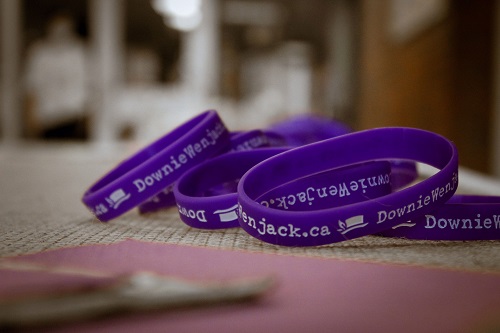
Since 2019, SDSS has coordinated an assembly on residential schools called, "Reconciliation through ReconciliACTIONs", weekly Indigenous music (with artist and background recognized), and increased content in the curriculum. As of now, the school also offers the transformation of its front hall as a lasting legacy.
The taped portion of the assembly included images narrated by Reconciliation Team members, Elder Ningwakwe George, teacher advisor Nancie Darlington Smith, graduate Cydney Morris, First Nation student senators Sonny Pilon (2020-21) and Ireland Sawyer (2021-22), teachers Bud Halpin, Alyssa Dunlop, and Pat Vanderholst. The intent was to introduce the makeover of the front hall through three main components.
The first component, a three-paneled wall display, includes three sections of texts that act as an introduction and overview to answer two questions: "Why is this important? What can we do?" The panels speak to the importance of reconciliation, recognition that we are guests on the land, and both the richness and value of Indigenous culture in a time where democracy and environments are threatened.
Cydney Morris, team member, recognized that it was "important to tie the Seven Grandfather Teachings of Love, Respect, Courage, Honesty, Wisdom, Humility, and Truth - honouring the basic virtues to lead a full and healthy life, to actions that we can do to work towards engaging and empowering others to further reconciliation through ReconciliACTION."
The creatures representing each of the teachings are beautifully illustrated by SDSS graduate Taylor Cameron, who identifies himself as "an emerging woodland artist from Saugeen First Nation No. 29. His paintings highlight the beauty of the natural world around us using vivid colour schemes that introduce a different perspective on animals, landscapes, and teachings." As for all contributing artists, a biography is included in the display case.
A display case outfitted with the assistance of Reed Bedard, a student in the Off-Site Construction Technology program, includes banners documenting the history of SON with a glossary of terminology on the back.
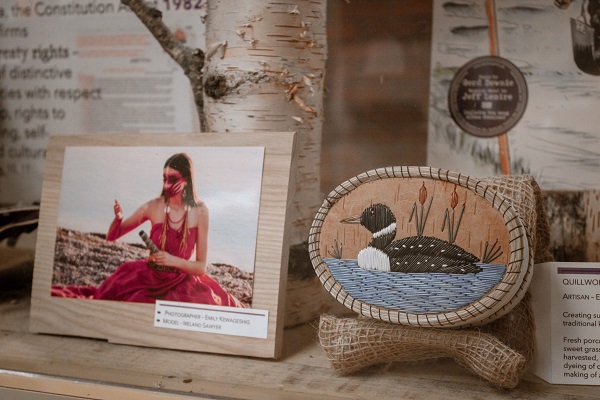
Framed by the banners are:
1) Illustrations of the Saugeen Ojibway Nation Traditional Territory, and a map showing the great distances from home that children from Saugeen First Nation were taken within the 165-year history of Canada's residential school system. Both water colours were prepared by Rowan Stephenson, a recent graduate of SDSS.
2) Copies of Treaty 45 ½ and 72, both referenced in the assembly by Mr. Vanderholst with the following acknowledgement: "The Crown broke their promises, and 25 years ago, a claim was launched to hold the Crown accountable for this injustice. Today, some agreements have been made, and reparations and commitments to reconciliation must continue to be upheld." (McCormack, July 29, 2021) Treaties were understood by Indigenous peoples as agreements to share the land - as the source of life. As the European concept of legal title to land was not familiar in traditional culture, First Peoples were at a significant disadvantage in treaty talks.
3) A map of "Saukiing Anishnaabekiing: Saugeen Ojibway Nation Treaties" with a caption that the Anishinaabemowin word SAUKIING', meaning river mouth', has been anglicized to Saugeen' (McNichol, 19-05-2019, Owen Sound Hub).
4) Biographies of contributing artists are showcased on the back of these documents.
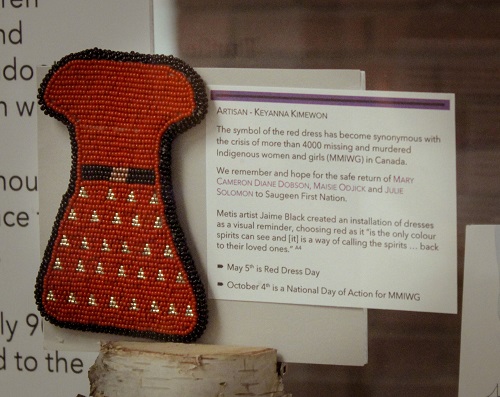
At the base of the display case are works of art by local Indigenous artists, members of Saugeen First Nation No. 29:
1) A quill box made of porcupine quills, birchbark, and sweetgrass - a rare and specialized item made by the skilled artisan Lorraine Besito, whose work has been displayed in galleries around the world.
2) Honouring the more than 4,000 MMIWG, a beaded red dress by Keyanna Kimewon, who reflects on the current state of affairs in Canada: "There is a lot of talk about the acknowledgment of what happened to Indigenous people, but there is not much action behind it. [It is not] just knowing the truth, but the justice part, where they should actually address and make amends with everything that happens, and is still happening, like MMIW, communities without clean water, and the systemic racism that is still prevalent in this country."
3) A beaded graduation cap by Marsha Reany, a Sixties Scoop survivor, member of the SON and Turtle Clan, adult graduate and educational assistant at SDSS, social worker, and beader. Above all else, Marsha will tell you that "beading is healing."
Other materials in the display case include:
1) A copy of the Truth and Reconciliation Commission's Summary of the Final Report. Having read the document, Nancie Darlington Smith, teacher advisor to SDSS' Reconciliation Team, said, "the commission did all the leg work - the research, including holding hearings with survivors and fighting the government for access to information; the compilation of the history; and, importantly, providing Canadians with a map for reconciliaction via their 94 Calls to Action. It is incumbent upon us to now act."
2) A deer hide and ash drum - with permission to showcase it as an educational tool and the understanding that drums are not to be used for decoration. Sonny Pilon, SDSS' 2020-21 First Nation student senator and Reconciliation Team member, shared the meaning of the drum during the virtual assembly: "Drumming is a way to bring people of all walks of life together. It is a time for everyone to connect with not just each other, but also Mother Earth and all living things. The drumming circle is a symbol of unity and unbrokenness, one that has stood since time immemorial."
3) A copy of Gord Downie and Jeff Lemire's graphic novel, "Secret Path". From the publisher's website, this book "acknowledges a dark part of Canada's history - the long-suppressed mistreatment of Indigenous children and families by the residential school system - with the hope of starting our country on a road to reconciliation."
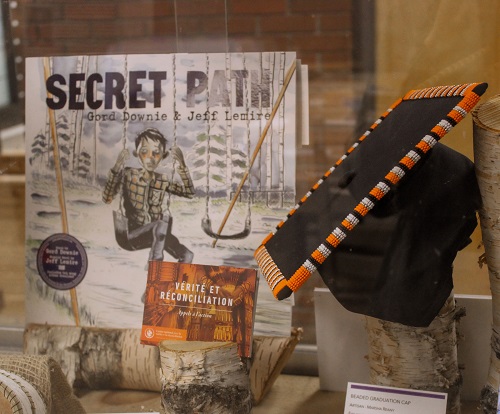
Perhaps the most eye-catching element of SDSS' Reconciliation Hall is a substantial oak table, constructed by three Off-Site Construction Technology students - Reed Bedard, Riley Campbell, and Ira Kimewon. The table surrounds a collaborative piece of art created during Treaties Recognition Week in 2019 under the guidance of accomplished Saugeen First Nation community member Emily Kewageshig, with the assistance of SDSS graduate Rachel Shave.
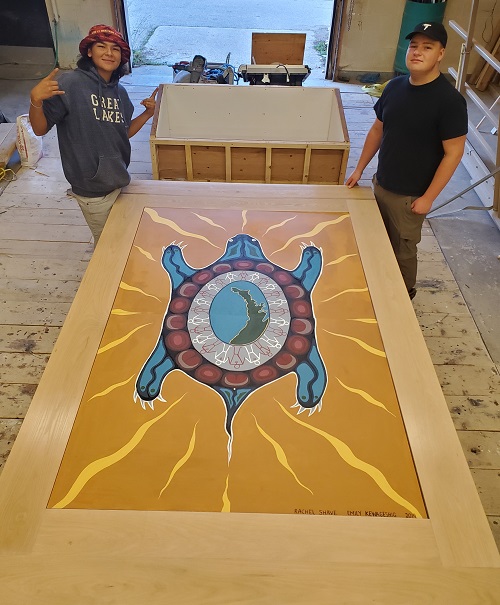
With Kewageshig's inspiration from traditional Ojibway Woodland artists and an Indigenous world view, and Shave's reflection that as a treaty person, "it is all of our responsibilities to do what we can to decolonize Canada, and contribute through collaborative artwork to bring about reconciliation," SDSS students gave life to an illustration that will serve as an influential visual and study space.
In designing the project, Kewageshig noted that, "the focus of the artwork is a turtle, which represents Turtle Island (North America) and the land we currently live on. In the middle of the turtle's shell is the [Saugeen] Peninsula, which is where Treaty No. 72 was signed in 1854. Surrounding that is imagery of figures holding hands and circling the interior of the shell. These figures were inspired by a historic rock carving that depicts a man standing with his arms out in an action of giving and receiving."
As noted by Elder Lori Kewaquom, Saugeen Advocacy for Healing Program Coordinator, the definition of reconciliation is "to return to that harmonious relationship. We never had a harmonious relationship. So, for me, we need to learn reconciliations. But we have to learn that within ourselves first - each individual person - before we can begin that journey with somebody else." Her message for healing is for all, "not just Anishnaabe people - to remember who we are, to remember our ancestors."
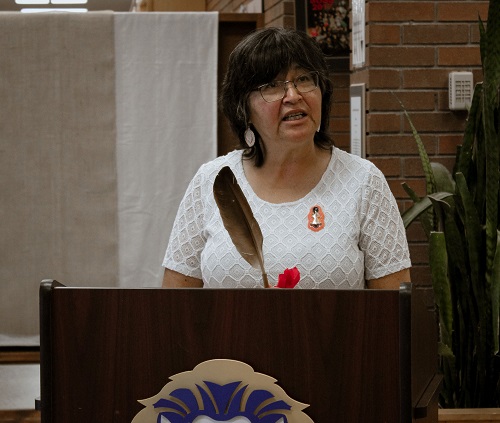
Elder Kewaquom noted that many people are disconnected, including non-Natives:
"For us, as Anishnaabe people, because of the disconnections that happened, we need to find our identity that was taken away from us. We were told that who we were was not a good thing - and they went through children to do that. They knew what they were doing. It was a plan. So, what we need to do now is to protect our children and give them back their identity of culture, [and] as much as we can the language, because the language is in crisis. A lot of our people that were language carriers are now gone. So we just have to do the best that we can and not feel bad about it - because it is not our fault."
"Regaining a connection to spirit to all creation, all living things - mind, body, spirit' - that is what we have to regain."
Elder Kewaquom recognizes that "this will be achieved through empowerment." In order to achieve this, emotions must be dealt with, understanding responses and reactions to the pain. On this journey of healing, "it is important to do the individual healing, discovery, [and] empowerment first."
Reflecting on the words of the Honourable Murray Sinclair, Chair of the Truth and Reconciliation Commission, that opened the assembly: "As long as our hearts are aimed in the right direction and we are moving in the right way, we will get there."
The virtual assembly and unveiling of Reconciliation Hall had its motivation in this message - that the truth of this nation's history has to be exposed, but that we need to also recognize and celebrate Indigenous values, contributions, and successes.
For example, a Haudenosaunee philosophy that is being realized in our modern society and economy is that we must consider the consequences of actions for seven generations. That long-term thinking is equally necessary in considering whether the decisions we make today will benefit those living over the course of the next 140 years.
With an ecological worldview, Indigenous communities see the entirety of life around holistic relationships and sustainability. This is the reality we need - and the world appears ready to listen.
Elder, poet, activist, educator, and artist, Dr. Duke Redbird, who is also a member of Saugeen First Nation and nephew of the late James Mason, delivered a keynote address to the Massachusetts Institute of Technology on the growing influence of Indigenous thinking and practices on the world of technology and higher learning.
To close the assembly, Dr. Redbird's poem, "Power of Land", set to music by the Sultans of String, beautifully delivered his message that, "we have to think about the land and our place on it. Our elders shared the wisdom of the land, and that is the essence of the piece."
All Canadians have been called upon by the Honourable Murray Sinclair, through the Truth and Reconciliation Commission, to "demonstrate the same level of courage and determination as the survivors of Canada's residential school system, as we commit to an ongoing process of reconciliation. By establishing a new and respectful relationship between Aboriginal and non-Aboriginal Canadians, we will restore what must be restored, repair what must be repaired, and return what must be returned." (TRC, 2015, 7 of 200)
A starting point for readers might be the consideration of the reflections that teachers wrote on their boards prior to the assembly and followed up with:
What does it mean to be open-minded?
What does reconciliation mean to you?
What role have you played, +/-, in reconciliation?









